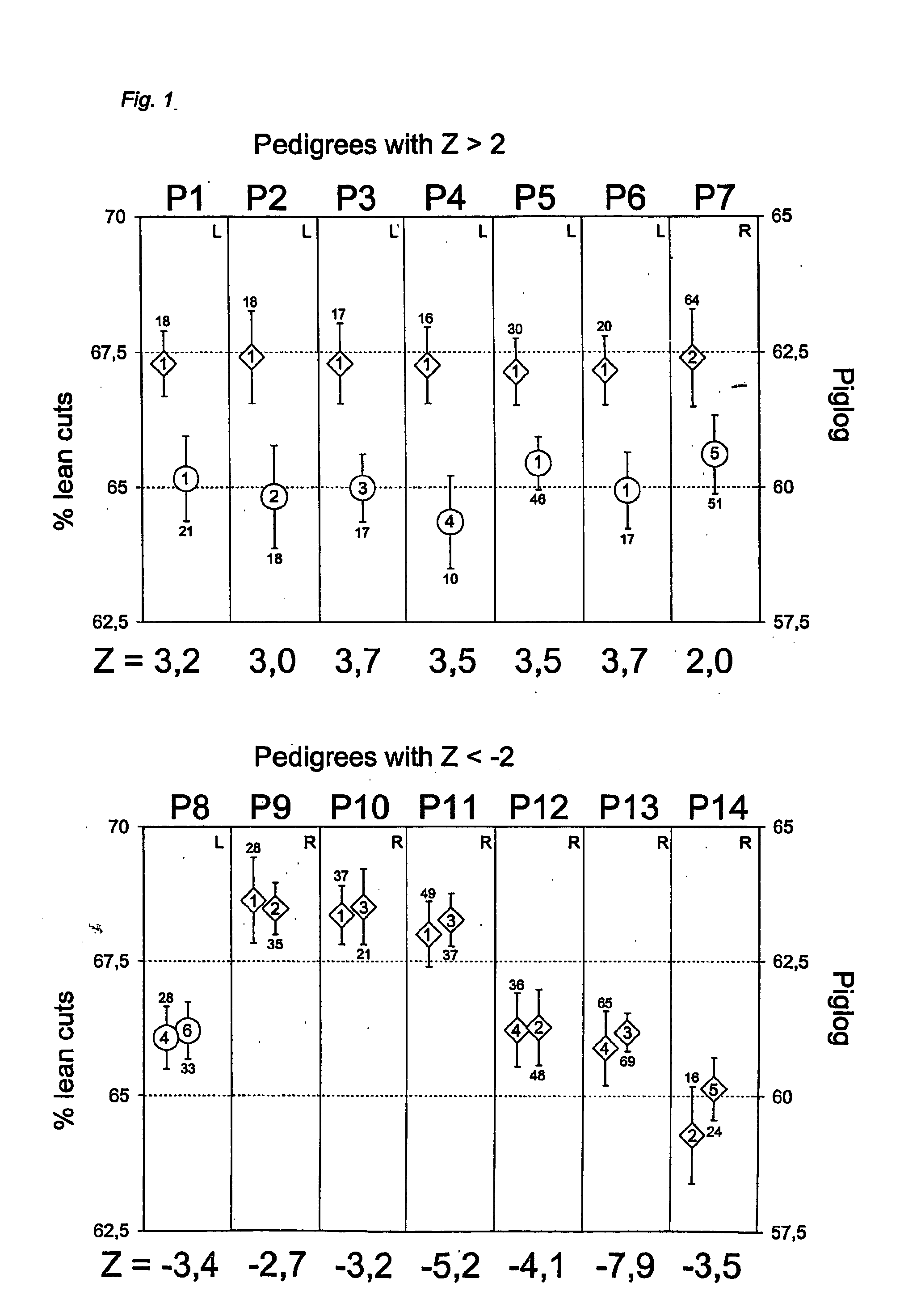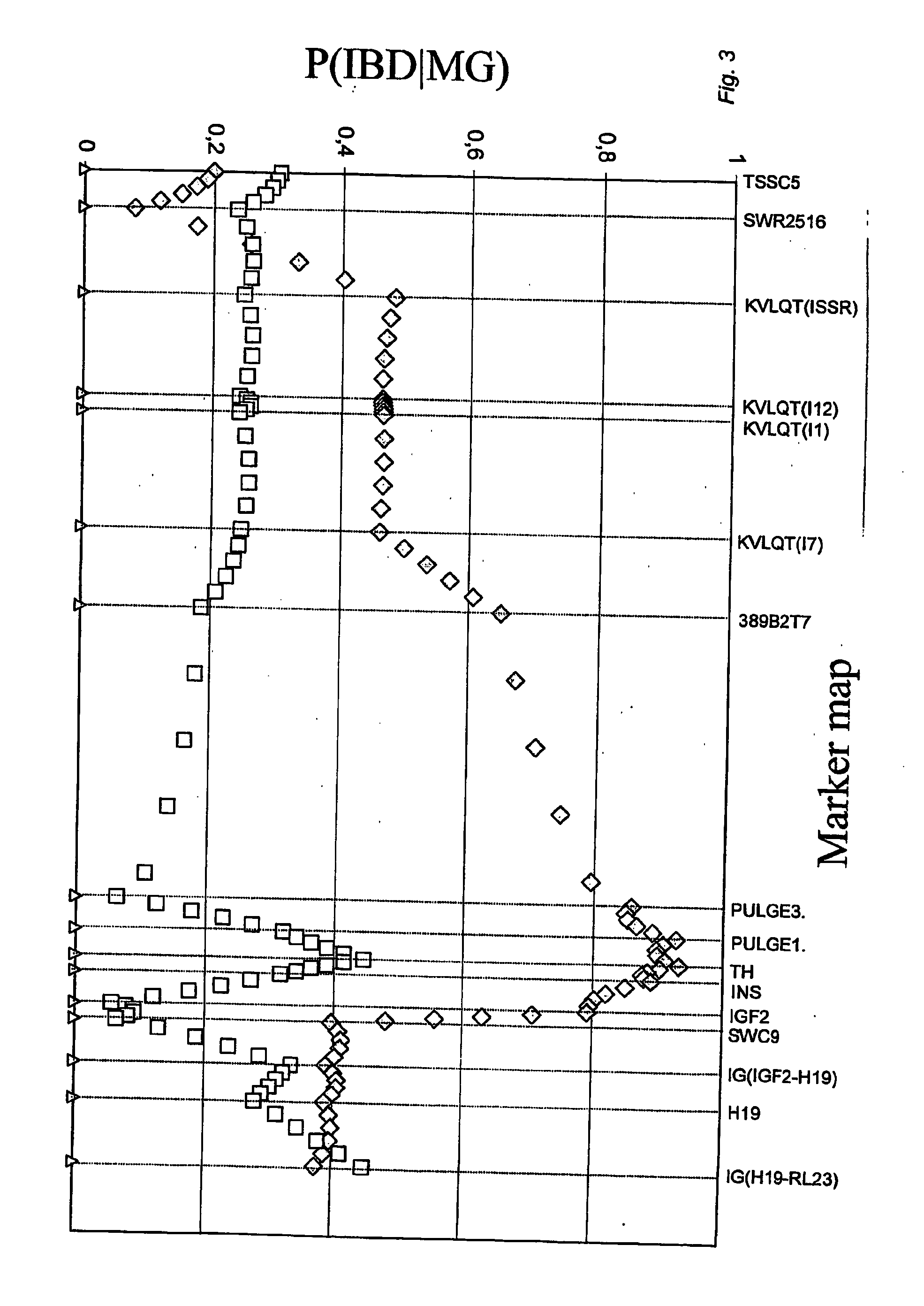Selecting animals for desired genotypic or potential phenotypic properties
a genotypic or potential phenotypic technology, applied in the field of methods of selecting animals, can solve the problems of negative genetic correlation between reproductive capacity and production traits, and is ever considered feasible to employ this elusive genetic characteristic, and achieve the effects of reducing back fat, enhancing teat number, and increasing muscle mass
- Summary
- Abstract
- Description
- Claims
- Application Information
AI Technical Summary
Benefits of technology
Problems solved by technology
Method used
Image
Examples
example 3
The Mutation has an Effect on Teat Number
[0090] Sires of two commercial lines were genotyped for the mutation. Shortly after birth, the number of teats was counted in all piglets. Piglet counts ranged from 12 to 18 teats and included 4477 individuals from 22 sires. A statistical analysis of teat number in piglets was performed by accounting for the following effects: 1) genetic line (lines A and B), 2) genotype of the sire for the mutation (QQ, Qq or qq) and 3) sex of the piglet (male / female). Analysis of variance was performed using Proc Mixed (SAS), assuming normality of dependent variable teat number. Estimates of some contrasts are given in Table 4.
[0091] The effect of genotype on teat number in piglets is −0.28 teats. This effect is opposite to the one described by Hirooka et al. 2001. An effect of genetic line could not be demonstrated. The sex of the piglet had a significant effect on teat number with female pigs having an average of 0.05 teat more than males. Mean values p...
example 1
REFERENCES WITH EXAMPLE 1
[0095] AMARGER, V., M. NGUYEN, A. S. VAN LAERE, C. NEZER, M. GEORGES, and L. ANDERSSON, 2002. Comparative sequence analysis of the INS-IGF2-H19 gene cluster in pigs. Mammalian Genome 13:388-398. [0096] ANDERSSON, L. 2001. Genetic dissection of phenotypic diversity in farm animals. Nature Reviews Genetics 2:130-138. [0097] ARDLIE, K. G., L. KRUGLYAK, and M. SEIELSTAD, 2002. Patterns of linkage disequilibrium in the human genome. Nat. Rev. Genet. 3:299-309. [0098] BLOTT, S., J.-J. KIM, S. MOSIO, A. SCHMIDT-KÜNTZEL, A. CORNET, P. BERZI, N. CAMBISANO, C. FORD, B. GRISART, D. JOHNSON, L. KARIM, P. SIMON, R. SNELL, R. SPELMAN, J. WONG, J. VILKKI, M. GEORGES, F. FARNIR, and W. COPPIETERS (2002). Molecular dissection of a QTL: a phenylalanine to tyrosine substitution in the transmembrane domain of the bovine growth hormone receptor is associated with a major effect on milk yield and composition. Genetics, in the press. [0099] DARVASI, A. 1998. Experimental strategie...
example 2
REFERENCES AND NOTES WITH EXAMPLE 2
[0120] 1. C. Nezer et al., Nature Genet. 21, 155-156 (1999). [0121] 2. J.-T. Jeon et al., Nature Genet. 21, 157-158 (1999). [0122] 3. D. J. De Koning et al., Proc. Natl. Acad. Sci. U.S.A. 97, 7947-7950 (2000). [0123] 4. H. Thomsen, J. C. M. Dekkers, H. K. Lee, and M. Rothschild, paper presented at the 7th World Congress of Genetics Applied to Livestock Production, Montpellier, France 2002. [0124] 5. C. Nezer et al., submitted (2003). [0125] 6. J. R. Florini, D. Z. Ewton, and F. J. Mcwade, Diabetes Rev. 3, 73-92 (1995). [0126] 7. V. Amarger et al., Mammalian Genome 13, 388-398 (2002). [0127] 8. G. J. Evans et al., Genetics in press (2003). [0128] 9. QTL genotyping of the Pietrain / Large White, Wild Boar / Large White, and Hampshire / Landrace crosses by marker-assisted segregation analysis was performed as described (5). Briefly, the likelihood of the pedigree data was computed under two hypothesis: H0, postulating that the corresponding boar was homozyg...
PUM
| Property | Measurement | Unit |
|---|---|---|
| Dimensionless property | aaaaa | aaaaa |
| Composition | aaaaa | aaaaa |
Abstract
Description
Claims
Application Information
 Login to View More
Login to View More - R&D
- Intellectual Property
- Life Sciences
- Materials
- Tech Scout
- Unparalleled Data Quality
- Higher Quality Content
- 60% Fewer Hallucinations
Browse by: Latest US Patents, China's latest patents, Technical Efficacy Thesaurus, Application Domain, Technology Topic, Popular Technical Reports.
© 2025 PatSnap. All rights reserved.Legal|Privacy policy|Modern Slavery Act Transparency Statement|Sitemap|About US| Contact US: help@patsnap.com



